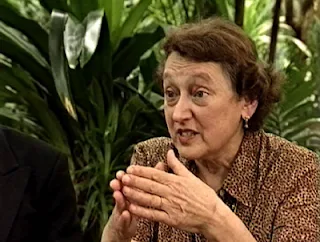Lynn Margulis was one of the most original, fearless and important scientists of our age. She died on November 22 at age 73. Here's her Washington Post obit.
She studied the smallest forms of life, and developed theories and spoke about larger issues that eventually encompassed the Earth. In fact she formulated the Gaia Theory, along with James Lovelock.
Her most important and striking work was a modification of evolutionary theory that was considered heretical. She particularly butted heads with Richard Dawkins and the neo-Darwinists, who saw genes as the missing element in Darwin's theory of natural selection and the origin of species by means of random mutations. But Dawkins and Darwin and other evolutionary theorists came out of the zoology tradition, she maintained--to them, only the big organisms mattered, the plants and animals. She studied fungi, slime, algae and especially bacteria, which comprise most of the life on the planet. She saw how microorganisms changed by symbiosis, by an eventual mutual dependence and a kind of cooperation. More complex forms emerged from this combination, a process called endosymbiosis. Another important element was the role of these processes that had nothing directly to do with genes. "There's much more to life than genes," she maintained.
This cut to the heart of a larger implicit view. The selfish gene was singular, always out for itself. Symbiosis suggested that organisms are created and thrive by working together for mutual benefit. Since neither of these processes is likely to be conscious on that level, these are descriptions that turn into metaphors for an approach to the world, just as theories of evolution always have.
Margulis applied her approach to humanity, and its inborn need to cooperate in order to survive. At the end of one event captured by C-SPAN cameras she got the audience to clap rhythmically to suggest the human propensity to cooperate in the rhythm of the hunt. Through millions of years it has become part of us--we need to breathe together. "If we don't use both our feelings and our rational approach we can't understand this [Earth] of which we are a part."
On an even larger scale, she brought greater rigor to Lovelock's Gaia Hypothesis, which she defined as a set of ecosystems where the cycling must be complete. Bacteria is as essential to life--to human life as well--as any other factor. Diversity is not just a pleasant idea, it is how this system of systems works. And understanding this was part of her mission: to understand "how the planet works and how many people can survive on the planet at what quality of life."
From her first paper on symbiogenesis in 1967, it took some 30 years until her theories were accepted. But she never wavered. "I don’t consider my ideas controversial,” she said. “I consider them right.”
Her first marriage was to astronomer Carl Sagan, and several of her books are coauthored with their son, Dorion Sagan--for example, the book that brings all these elements together: Acquiring Genomes: A Theory of the Origin of Species.
Starting the Long Season
-
The* Golden State Warriors* have a hellish schedule to start the season:
several back to backs, several three games in four nights, and now a dozen
road...
2 weeks ago













No comments:
Post a Comment